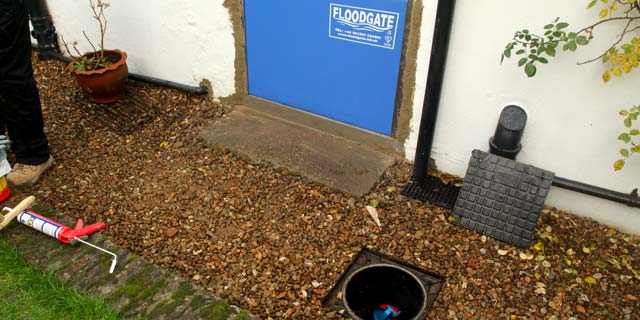Well, we can’t say they didn’t warn us about climate change; more rain, rising seas, extreme weather. The television is full of images of flooding homes and the miserable aftermath. People being interviewed say that they have never known it this bad. Houses that were once considered above the flood plain, are now being deluged and everyone is looking for someone to blame for the flooding. Try Jeremy Clarkson.
Flooding needs to be tackled long before the water reaches town…
A week before the flooding I was down in Kent, with a company that was installing Smart Air Bricks, backflow prevention devices, and Flood Gates in a vulnerable cottage near the river Medway. It was just in time for the latest deluge, but did those preventative measures work? To some extent yes, in that they kept the water out to the specified height, but the water was higher than it had ever been; there comes a point (around 750mm) where it is better to let the water into the house, in order to equalize the water pressure on both sides. If this is not done then there is a risk of the walls being pushed in.
An interesting thing about water pressure is that it’s directly proportional to the height of water (static head) and is not affected by the amount of water that lies behind it. So a two foot wall at the end of Lake Windermere will have the same pressure on it as a two foot wall around a swimming pool. This allows us to calculate the forces precisely. However this doesn’t allow for surges. If the water is travelling towards you in a wave, that energy has nothing to do with static head.
Water will also find its own level so what you have on the inside you have on the outside, which is useful because it stops the walls being pushed in. In the case of a cellar flooding, it’s unwise to pump it out if the water table on the outside is too high. It may also be futile.
That said, it’s heartbreaking to stand and watch your home being flooded and any small thing you can do to reduce the impact of flooding must be better than simply sitting there watching nature take its course.
There is a great deal that can be done to reduce risk of minor flooding starting with the use of basic sandbags, and then moving up the scale in terms of expense, but not necessarily effectiveness. In particular you should not neglect the loo. You can sandbag all around the house but if the water level rises it has a route in through the drains and can pour out through the loo.
Leaving aside DIY flooding solutions, lots of people are now asking what more the Department of the Environment can do. One thing is certain, the problem needs to be tackled long before the water reaches town. In some cases this might mean diverting rivers and water courses or building sea defences. It might also mean building homes higher out of the ground. There is no reason why this can’t be done; it’s done all over the world. Houses on stilts! The technology has been there for centuries we have just been too complacent.
Flooding aside, there are also people who are finding water coming into their house through the roof and walls where it has never appeared before. If you get enough rain, it will drive through brickwork and mortar courses, which is why some of those DIY flood prevention devices are dubious.
In the normal course of events with heavy rain you wouldn’t necessarily know it’s happening, because the water runs down the inside of the outer skin, and is drained through weep holes in the mortar courses. However, problems often occur where the house has been extended on the ground floor, and a wall which was previously on the outside now finishes on top of a steel beam. Where then, is that water which runs down between the inner and outer wall going to go when it hits the beam?
The answer for many is into their nice new extension. If the builder has been diligent, this won’t happen because he/she will have put in cavity trays above the newly formed opening. The trays need to be above the roof line so the water can be drained out onto the extension roof, but I know many builders who simply don’t bother doing this, because it involves chopping out mortar courses and inserting the trays one by one to form a cascade. In most cases they get away with it because the rain never normally manages to drive that far through the brickwork, but we live in extraordinary times.
People are talking about ‘freak’ weather conditions. I love the use of the word ‘freak’ it’s applied to all sorts of things that really don’t warrant it. Admittedly the weather is unusual but storms are not freaks of nature. The British Building Regulations recognise this, and makes provision for unusual weather. That is why the regulations specify cavity trays. So the builder who glibly says to the client, “yeah we are dealing with freak weather conditions here”, is looking to blame something other than his/her negligence.
The opposite to negligence is zealousness or over-zealousness. I often see instances where home owners have spotted those weep holes above the window lintels, or on the cavity trays and filled them up, believing them to be holes that were overlooked during the construction process. This for me is the easiest kind of problem to put right. It takes ten minutes with a masonry drill to clear them out. Sometimes you are treated to a nice little jet of water coming out of the hole. It is as satisfying as lancing a boil.




